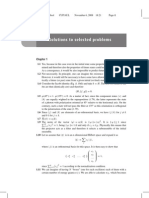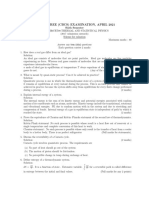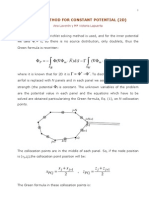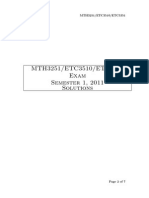4211 Slides 2
4211 Slides 2
Uploaded by
Roy VeseyCopyright:
Available Formats
4211 Slides 2
4211 Slides 2
Uploaded by
Roy VeseyOriginal Description:
Copyright
Available Formats
Share this document
Did you find this document useful?
Is this content inappropriate?
Copyright:
Available Formats
4211 Slides 2
4211 Slides 2
Uploaded by
Roy VeseyCopyright:
Available Formats
1.
6 Classical Statistical Mechanics
http://personal.rhul.ac.uk/UHAP/027/PH4211/
b.cowan@rhul.ac.uk
4211 Statistical Mechanics 1 Week 2
Classical Statistical Mechanics
• Classical Mechanics is best formulated in terms of position (q) and momenta (p)
coordinates (inc. generalized coordinates).
• So we would say a state is specified when we know all the position and
momenta coordinates.
• The p − q space is called phase space.
• So in classical mechanics a state is a point in phase space.
• Difficulty in counting such states since p and q vary continuously; there would
be an infinite number of states in any region of phase space.
• In Statistical Mechanics it is expedient to erect a grid in phase space with cells
Δqx Δqy Δqz Δpx Δpy Δpz.
4211 Statistical Mechanics 1 Week 2
• In classical statistical mechanics
a state corresponds to a cell in
phase space.
• I.e. a system is in a given (micro)
state if it is in a specified cell in
phase space.
A state in phase space.
• What should be the size of the
cells?
• Dimension of p × q is action (like
in Planck’s constant h).
4211 Statistical Mechanics 2 Week 2
• We argue that the precise size of the cells should not be important.
• But we note that Quantum Mechanics (Uncertainly principle) tells us we cannot
discern a state to finer than a Δp Δq cell smaller than Planck’s constant.
Our Philosophy
• We shall write the size of a Δp Δq cell as h. At this stage its size will be un-
determined. Later, by comparing results with those calculated by quantum
statistical mechanics, we will identify this h as Planck’s constant.
Connection between classical/quantum statistical mechanics
• The general rule is that sums over states in the quantum case correspond to
integrals over phase space in the classical case.
1
∫
→ 3 d3p d3q
∑ h
single particle states
Note the appearance of the h factors ensures dimensionality.
4211 Statistical Mechanics 3 Week 2
1.6.2 Boltzmann and Gibbs Phase Spaces
.
4211 Statistical Mechanics 3 Week 2
1.6.3 The Fundamental Postulate in the Classical Case
The classical version of the Fundamental Postulate states that for an
isolated system all available regions of phase space on the constant
energy hypersurface are equally likely.
4211 Statistical Mechanics 4 Week 2
1.6.4 The classical partition function
The classical analogue of the quantum partition function is given by
1
Z = 3N ∫ e−H ( pi ,qi ) kT d 3N p d 3N q
h
The function H ( pi ,qi ) is the energy of the system expressed as a
function of the position and momentum coordinates {qi } and {pi } . This
is the Hamiltonian.
4211 Statistical Mechanics 5 Week 2
1.6.5 The equipartition theorem
Energy of ith degree of freedom
1
Ei = ∫ Ei e ( 1 i N 1 i N ) d 3N q d 3N p
− E q ...q ...q , p ... p ... p kT
− − no pi − −
↓ ↓
− E ( q1 ...qi ...qN , p1 ..... pN ) kT
∫ i dpi ∫ e
− Ei
E e kT
d 3 N q d 3 N −1 p
Ei =
∫ e − Ei kT
dpi ∫ [same integral as above - no pi ]
∫ i
− Ei kT
E e dpi
Ei =
∫
− Ei kT
e dpi
Use the beta trick: β = 1/kT….
4211 Statistical Mechanics 6 Week 2
gives
− β Ei ∂ − β Ei
Ei e =− e
∂β
so that
1
Ei = − − β E
∂
∫
− β Ei
e d pi =
∂
ln ( ∫ d pi
e − β Ei
)
∫ e d pi ∂β
i ∂β
4211 Statistical Mechanics 7 Week 2
1.6.6 Consequences of equipartition
• Each “quadratic” degree of freedom gives internal energy kT/2 .
• Lattice vibrations (p and q contributions): CV = 3R per mol.
3
• Gas of particles (only p contribution): CV = R per mol.
2
Equipartition breaks down when quantum effects become important – at
low temperatures.
4211 Statistical Mechanics 8 Week 2
1.6.7 Liouville’s theorem
Entropy – classical analogue of
S = −k ∑ Pj ln Pj = −k ln P
j
is
S = −k ∫ ρ ln ρ d n p d n q = −k ln ρ
where ρ ( pi ,qi ,t) = density of points in phase space.
Evolution of S (or ρ) with time? Should be consistent with Second Law.
But… Liouville’s theorem →
dρ
=0
dt
- S appears to remain constant !!!!!!!!!
4211 Statistical Mechanics 9 Week 2
1.6.8 Boltzmann’s H theorem
1 2
Evolution of a region of phase space
4211 Statistical Mechanics 10 Week 2
1.6.8 Boltzmann’s H theorem
1 2
Evolution of a region of phase space
evolves to which
appears as
Apparent reduction in density in phase space
4211 Statistical Mechanics 11 Week 2
Chapter 2
Practical Calculations with Ideal
Systems
2.2 Identical Particles
4211 Statistical Mechanics 12 Week 2
2.2.1 Indistinguishability
If we had an assembly of N identical but distinguishable particles the
resultant partition function would be the product of the (same) partition
functions of a single particle, z
Z = zN .
The key question is that of indistinguishability of the atoms or
molecules of a many-body system. When two identical molecules are
interchanged the system is still in the same microstate, so the
distinguishable particle result overcounts the states in this case.
4211 Statistical Mechanics 13 Week 2
Now the number of ways of redistributing N particles when there are n1
particles in the first state, n2 particles in the second state etc. is
N!
n1 ! n2 ! n3 !......
so that for a given distribution {ni} the partition function for identical
indistinguishable particles is
n1 ! n2 ! n3 !...... N
Z= z .
N!
4211 Statistical Mechanics 14 Week 2
2.2.2 Classical approximation
In the classical case we have then
1 N
Z= z .
N!
The Helmholtz free energy
F = −kT ln Z
is thus
F = − NkT ln z + kT ln N ! .
This is N times the Helmholtz free energy for a single particle plus an
extra term depending on T and N. So the second term can be ignored so
long as we differentiate with respect to something other than T or N.
Thus when differentiating with respect to volume to find the pressure,
the result is N times that for a single particle.
4211 Statistical Mechanics 15 Week 2
2.3 Ideal Classical Gas
2.3.2 Classical approach
The classical partition function is given by the integral
1 −ε kT 3 3
z = 3 ∫e d pd q
h
where for the ideal gas ε = p 2
2m . Thus the q integrals are trivial,
giving a factor V, and we have
3
V ⎡ − p2 2 mkT ⎤
∞
z= 3 ⎢∫ e dp ⎥
h ⎣ −∞ ⎦ .
The integral is transformed to a pure number by changing variables:
p = x 2mkT so that
3
32⎡ ⎤
∞
V
z = 3 ( 2mkT ) ⎢ ∫ e dx ⎥
− x2
h ⎣ −∞ ⎦.
4211 Statistical Mechanics 16 Week 2
As in the quantum calculation, the physics is all outside the integral and
the integral is just a pure number. The value of the integral is π so
that
32
⎛ 2π mkT ⎞
z =⎜ 2 ⎟ V
⎝ h ⎠
just as in the “quantum” calculation. This justifies the use of h in the
normalization factor for the classical state element of phase space.
Write
V h
z= 3, where Λ= .
Λ ( 2π mkT )
32
Here Λ is known as the thermal de Broglie wavelength. It has a very
important meaning.
4211 Statistical Mechanics 17 Week 2
2.3.3 Thermodynamic properties
We start from the Helmholtz free energy:
⎡⎛ 2π mkT ⎞3 2 Ve ⎤
F = −kT ln Z = NkT ln ⎢⎜ 2 ⎟ ⎥
⎢⎣⎝ h ⎠ N ⎥⎦ ,
giving
∂ ln Z ∂ ln z NkT
p = kT = NkT =
∂V T , N ∂V T V .
This is the ideal gas equation, and from this we identify k as
Boltzmann’s constant.
The internal energy is
∂ ln Z d ln T 32
3
E = kT 2 = NkT 2 = NkT
∂T V ,N dT 2 .
4211 Statistical Mechanics 18 Week 2
This is the result we obtained previously from equipartition. This gives
another important property of an ideal gas: the internal energy depends
only on temperature (not pressure or density). This is known as Joule’s
law. From the energy expression we obtain the thermal capacity
∂E 3
CV = = Nk
∂T V , N 2 .
This is a constant, independent of temperature, in violation of the Third
Law. This is because of the classical approximation – ignoring multiple
state occupancy etc. We also find the entropy and chemical potential:
⎡⎛ 2π mkT ⎞3 2 kTe5 2 ⎤
S = Nk ln ⎢⎜ 2 ⎟ ⎥,
⎢⎣⎝ h ⎠ p ⎥⎦
⎡⎛ 2π mkT ⎞3 2 kT ⎤
µ = −kT ln ⎢⎜ 2 ⎟ ⎥.
⎢⎣⎝ h ⎠ p ⎥⎦
4211 Statistical Mechanics 19 Week 2
Sackur-Tetrode equation
⎡⎛ 2π mkT ⎞3 2 kTe5 2 ⎤
S = Nk ln ⎢⎜ 2 ⎟ ⎥
⎢⎣⎝ h ⎠ p ⎥⎦
⇒
5
S = Nk ln T − Nk ln p + Nks0
2
• Latter equation can be derived by thermodynamics alone.
• Constant s0 known as the Sakur-Tetrode constant
Naïve interpretation of this equation is wrong.
4211 Statistical Mechanics 20 Week 2
2.3.4 The 1/N! term in the partition function
4211 Statistical Mechanics 21 Week 2
You might also like
- Wyndham Worldwide 1Document26 pagesWyndham Worldwide 1Jackie Gamez Garcia67% (3)
- The Llewellyn Practical Guide To Psychic S - Melita Denning Osborne PhillipsDocument1,339 pagesThe Llewellyn Practical Guide To Psychic S - Melita Denning Osborne Phillipstod9991% (11)
- Vspace Server X-6.2.7.2 Release NotesDocument2 pagesVspace Server X-6.2.7.2 Release Notesrcol1230% (1)
- 4.3 - Fraser, Nancy - Toward A Discourse of Ethic Theory (En)Document6 pages4.3 - Fraser, Nancy - Toward A Discourse of Ethic Theory (En)Johann Vessant RoigNo ratings yet
- 5.62 Physical Chemistry Ii: Mit OpencoursewareDocument6 pages5.62 Physical Chemistry Ii: Mit OpencoursewareavdvNo ratings yet
- Solutions To Selected Problems: K K K K N J J J JKDocument79 pagesSolutions To Selected Problems: K K K K N J J J JKdingo100% (2)
- 4211 Slides 3Document72 pages4211 Slides 3Roy VeseyNo ratings yet
- Molecular Dynamics Meets The Physical World: Thermostats and BarostatsDocument19 pagesMolecular Dynamics Meets The Physical World: Thermostats and Barostatscristian HaroNo ratings yet
- Thermostats and Barostats PDFDocument19 pagesThermostats and Barostats PDFVera SimilarNo ratings yet
- HW 2Document2 pagesHW 2zenon7010No ratings yet
- Lecture2 Semiconductor StatisticsDocument13 pagesLecture2 Semiconductor StatisticsRakib KhanNo ratings yet
- Assignment 1 SolutionsDocument5 pagesAssignment 1 SolutionsPrince MensahNo ratings yet
- Scheme-Thermal and Statistical PhysicsDocument6 pagesScheme-Thermal and Statistical Physicsammualee48No ratings yet
- Canonical PDFDocument2 pagesCanonical PDFTony Grigory AntonyNo ratings yet
- Lecture 04Document18 pagesLecture 04Anmol RajputNo ratings yet
- 5.62 Physical Chemistry Ii: Mit OpencoursewareDocument10 pages5.62 Physical Chemistry Ii: Mit OpencoursewareavdvNo ratings yet
- Singular Value Decomposition (SVD) / Principal Components Analysis (Pca)Document31 pagesSingular Value Decomposition (SVD) / Principal Components Analysis (Pca)Arindam ChakrabortyNo ratings yet
- Statistical Physics EPS: Basic DefinitionsDocument5 pagesStatistical Physics EPS: Basic DefinitionsEmreNo ratings yet
- Intro 2 MD SimulationDocument20 pagesIntro 2 MD SimulationachsanuddinNo ratings yet
- Introduction, Axioms, Bell Inequalities 1 Why Quantum Computation?Document7 pagesIntroduction, Axioms, Bell Inequalities 1 Why Quantum Computation?RicardoPrinsNo ratings yet
- PolytechnicDocument71 pagesPolytechnicEyüp TolgaNo ratings yet
- Lecture 05 PDFDocument42 pagesLecture 05 PDFM Bhargava SaiNo ratings yet
- Speed Up of Certain Type of Backtracking Algorithms With Applica8ons To Enumera8on of Higher Dimensional Par88onsDocument20 pagesSpeed Up of Certain Type of Backtracking Algorithms With Applica8ons To Enumera8on of Higher Dimensional Par88onsSrivatsan BalakrishnanNo ratings yet
- 5.60 Thermodynamics & Kinetics: Mit OpencoursewareDocument7 pages5.60 Thermodynamics & Kinetics: Mit OpencoursewarecaptainhassNo ratings yet
- UntitledDocument27 pagesUntitleddezevuNo ratings yet
- Week 5 - Multivariable in Momentum TransportDocument38 pagesWeek 5 - Multivariable in Momentum TransportMuhammad Yuzer IrosoneriNo ratings yet
- Second Quantization Lecture Notes With Course Quantum TheoryDocument20 pagesSecond Quantization Lecture Notes With Course Quantum TheoryPritam Kr. BangalNo ratings yet
- Lab 3fis AjarachiDocument6 pagesLab 3fis Ajarachipapitas602No ratings yet
- Free EnergiesDocument8 pagesFree EnergiesNicolás Alejandro Ávila PérezNo ratings yet
- Physical Chemistry Exam 1 KeyDocument8 pagesPhysical Chemistry Exam 1 KeyOsama GhaniNo ratings yet
- 8-1-0-CSP EegDocument83 pages8-1-0-CSP Eegs96281No ratings yet
- 4023 F 06 Ex 1 RevaDocument9 pages4023 F 06 Ex 1 RevaKumar Keshaw ShahiNo ratings yet
- Chapter 3Document14 pagesChapter 3StefanPerendijaNo ratings yet
- Assignment 1Document2 pagesAssignment 1Prince Mensah100% (2)
- Classical MechanicsDocument6 pagesClassical MechanicsSebastian Soto PerdomoNo ratings yet
- Bayes Intro PT 2Document13 pagesBayes Intro PT 2awelNo ratings yet
- 4211 Sheet 1Document2 pages4211 Sheet 1Roy VeseyNo ratings yet
- How To Cook A Quantum Computer: A. Cabello, L. Danielsen, A. López Tarrida, P. MorenoDocument53 pagesHow To Cook A Quantum Computer: A. Cabello, L. Danielsen, A. López Tarrida, P. MorenoZifra RaNo ratings yet
- 1 s2.0 S0195669821001645 MainDocument23 pages1 s2.0 S0195669821001645 MainDan DanielNo ratings yet
- EDC 1 - Semiconductor Physics - 2Document16 pagesEDC 1 - Semiconductor Physics - 2Ana-Maria Raluca ChiruNo ratings yet
- Summary FMCP: 1 Statistical MechanicsDocument17 pagesSummary FMCP: 1 Statistical MechanicsshreyashNo ratings yet
- Dimensions ReductionDocument27 pagesDimensions ReductionSmart AijazNo ratings yet
- Statistical PhysicsDocument37 pagesStatistical PhysicsLuc LeNo ratings yet
- Nonlinear Quadratic Dynamic Matrix Control With State EstimationDocument32 pagesNonlinear Quadratic Dynamic Matrix Control With State EstimationLetian WangNo ratings yet
- L23 - Postulates of QMDocument24 pagesL23 - Postulates of QMdomagix470No ratings yet
- Grand Canonical EnsembleDocument15 pagesGrand Canonical EnsembleRian AshariNo ratings yet
- Exam QM2Document6 pagesExam QM2Konstantinos AlexiouNo ratings yet
- hw1 SolDocument7 pageshw1 SolyawarhkNo ratings yet
- Panel Methods For Constant PotentialDocument4 pagesPanel Methods For Constant Potentialdrkarimaa3791No ratings yet
- MicrocanDocument2 pagesMicrocanAnonymous qeCHJHmMTNo ratings yet
- CM 19 One D CrystalDocument9 pagesCM 19 One D CrystalChandra ManikNo ratings yet
- Intro2CFD Lecture1 Pulliam Intro SlidesDocument22 pagesIntro2CFD Lecture1 Pulliam Intro SlidesVladimir JovanovicNo ratings yet
- L7n8n9 Molecular InteractionDocument10 pagesL7n8n9 Molecular InteractionJainil PatelNo ratings yet
- Probability and StatisticsDocument90 pagesProbability and StatisticsNala A.100% (1)
- Lecture 3 General ChemistryDocument18 pagesLecture 3 General ChemistryRitik UpmanyuNo ratings yet
- Statistical Mechanics Lecture Notes 3 - Quantum Statistics and Its ApplicationsDocument50 pagesStatistical Mechanics Lecture Notes 3 - Quantum Statistics and Its ApplicationsMegha soniNo ratings yet
- INDUCTIONDocument15 pagesINDUCTIONaibyike.turdugalievaNo ratings yet
- 2009 Chopra Spong ACDocument6 pages2009 Chopra Spong ACSuprotim SahaNo ratings yet
- MM Reference 03 Mathematical Model HCDocument9 pagesMM Reference 03 Mathematical Model HCalisantosodarrian14No ratings yet
- Vector Norms and Matrix NormsDocument42 pagesVector Norms and Matrix NormsLucky DeltaNo ratings yet
- Introduction To (Statistical) ThermodynamicsDocument35 pagesIntroduction To (Statistical) ThermodynamicsPiousNo ratings yet
- Mod RaoultDocument20 pagesMod RaoultAraNo ratings yet
- Radically Elementary Probability Theory. (AM-117), Volume 117From EverandRadically Elementary Probability Theory. (AM-117), Volume 117Rating: 4 out of 5 stars4/5 (2)
- Chapter 3 - Power SeriesDocument19 pagesChapter 3 - Power SeriesAlex TanNo ratings yet
- Program: Allen BradleyDocument25 pagesProgram: Allen BradleyShahina Parvin ShaikNo ratings yet
- Ergonomics Risk AssessmentDocument130 pagesErgonomics Risk AssessmentYuli Wicahyo75% (4)
- WK5 SR MOD001074 Grundy 2006 PDFDocument18 pagesWK5 SR MOD001074 Grundy 2006 PDFadwiyahNo ratings yet
- Suplementary 5Document11 pagesSuplementary 5Jessica VasquezNo ratings yet
- Comp Eng 4Tl4:: Digital Signal ProcessingDocument12 pagesComp Eng 4Tl4:: Digital Signal ProcessingAlvaroNo ratings yet
- 02 Simon's ReplicaDocument8 pages02 Simon's ReplicaDean Francis Alfar100% (1)
- Artikel Peran Mediasi Person-Job Fit Dan Job ResourcesDocument8 pagesArtikel Peran Mediasi Person-Job Fit Dan Job ResourcesGlen FebrianNo ratings yet
- Ijssp Ms-The Normative Theory of Social Exclusion-Shepley OrrDocument19 pagesIjssp Ms-The Normative Theory of Social Exclusion-Shepley OrrvegetarianNo ratings yet
- HMBC and HMQCDocument13 pagesHMBC and HMQCArthur Girardi CarpanezNo ratings yet
- TQM Course ContentDocument22 pagesTQM Course ContentCriseldo CalinawanNo ratings yet
- Curriculum Vitae John D Greenwood Work AddressDocument15 pagesCurriculum Vitae John D Greenwood Work AddressContro PNo ratings yet
- 2011 Exam - Financial MathematicsDocument6 pages2011 Exam - Financial MathematicsSylvia HuynhNo ratings yet
- Maths PDFDocument17 pagesMaths PDFBhaskar NaiduNo ratings yet
- Chapter 1 Meaning and SemanticsDocument51 pagesChapter 1 Meaning and SemanticsThùy TrangNo ratings yet
- CombinedDocument70 pagesCombinedchirag yadavNo ratings yet
- 1 Period Test 10th (New6)Document4 pages1 Period Test 10th (New6)Châu Nguyễn Long TrangNo ratings yet
- Al Bawani Co. Near Miss ReportDocument2 pagesAl Bawani Co. Near Miss ReportZahir HSENo ratings yet
- Sistol GDS: Case Processing SummaryDocument4 pagesSistol GDS: Case Processing SummarygheaNo ratings yet
- Bond 11 Plus Maths 10 Minute Test SampleDocument2 pagesBond 11 Plus Maths 10 Minute Test Sampleoliviagt17No ratings yet
- Lecture 1 Mechanical AdvantageDocument70 pagesLecture 1 Mechanical AdvantagebourneNo ratings yet
- Futurama For Cortex: PremiseDocument5 pagesFuturama For Cortex: PremiseKaiserhuffNo ratings yet
- CHAPTER 13 NanoworldDocument11 pagesCHAPTER 13 NanoworldRussel Labog50% (2)
- Pasiol FinalDocument38 pagesPasiol FinalEarl Vincent V. LamaneroNo ratings yet
- Java Excersie2Document21 pagesJava Excersie2D-sumanNo ratings yet
- HP 3par Storeserv1Document5 pagesHP 3par Storeserv1Jagdeesh DassNo ratings yet

























































































